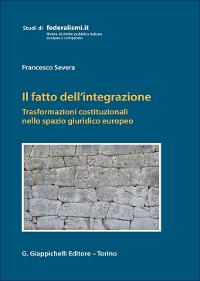
Log in or Create account
FOCUS - Territorio e Istituzioni N. 20 - 01/08/2022
Il territorio nelle politiche della sussidiarietà orizzontale: tra tentativi nazionali di “demarchia” e proposte europee per un approccio place based
Abstract [It]: Il paper affronta il tema della sussidiarietà orizzontale, art. 118.4 Cost., quale strumento utile a realizzare, attraverso la concertazione tra pubbliche amministrazioni e cittadini, politiche di governo del territorio, fondate su una forma di corresponsabilità dei singoli e delle formazioni sociali con l’amministrazione (il richiamo è alla recente sent. n. 131/2020). Nella seconda parte, si richiamano le politiche europee che hanno fatto importanti investimenti per favorire le forme di collaborazione tra le PP.AA e la società civile, con l’obiettivo di avviare e consolidare una partecipazione bottom up (ad esempio, i River Agreements (RA) e la National Strategy for Inner Areas (SNAI).
Title: Territory in the policies of horizontal subsidiarity: between national attempts at "demarchy" and European proposals for a place-based approach
Abstract [En]: The paper deals with the issue of horizontal subsidiarity (art. 118.4 of the Italian Constitution), as a useful tool to implement, through the consultation between public administrations and citizens, territorial government policies, based on a form of co-responsibility of individuals and social formations with the administration (the reference is to recent decision no. 131/2020). In the second part, we recall the European policies that have made important investments to improve forms of collaboration between the Public Administrations and civil society, with the aim of starting and consolidating a bottom-up participation (for example, the River Agreements (RA) and the National Strategy for Inner Areas (SNAI).
Parole chiave: sussidiarietà orizzontale, Codice del terzo settore, libertà sociali, bottom up approach
Keywords: Horizontal subsidiarity, Third Sector Code, social freedoms, bottom up approach
Sommario: 1. L’art. 118, ultimo comma, Cost.: tra amministrazione condivisa e tentativi di demarchia. 2. L’art. 118.4 Cost. e le “libertà sociali”. Evoluzioni interpretative e applicative della sussidiarietà orizzontale nell’ambito del terzo settore. 2.1. L’amministrazione condivisa nel Codice del terzo settore e la realizzazione dell’interesse generale. 3. Programmi per un’amministrazione condivisa nelle politiche europee. 4. Esempi nazionali di matrice europea per una governance integrata: i River Agreements e la National Strategy for Inner Areas. 5. Conclusioni.
NUMERO 19 - ALTRI ARTICOLI
-
ITALIA - DOTTRINA
L'indirizzo politico, dopo Covid e PNRR
ITALIA - DOTTRINAIl principio autonomistico e la questione dell’adeguatezza dimensionale. Riflessioni sull’associazionismo comunale nei suoi sviluppi normativi e giurisprudenziali
-
ITALIA - DOTTRINA
Regolazione per standard: un valore aggiunto?
ITALIA - DOTTRINASul concetto di beni “a destinazione pubblica”: beni culturali, interessi collettivi e diritto di prelazione
-
ITALIA - DOCUMENTAZIONE
Lavoro Persona Tecnologia - Contributi del 27 luglio 2022
ITALIA - DOTTRINANuovi alimenti, vecchi problemi



 Registrati
Registrati Login
Login
 Territorio e istituzioni
Territorio e istituzioni Lavoro Persona Tecnologia
Lavoro Persona Tecnologia America Latina
America Latina Africa
Africa Osservatorio di Diritto sanitario
Osservatorio di Diritto sanitario Osservatorio sul diritto elettorale
Osservatorio sul diritto elettorale Osservatorio Trasparenza
Osservatorio Trasparenza Human Rights
Human Rights Storico focus
Storico focus Riforme istituzionali e forma di governo
Riforme istituzionali e forma di governo Scarica il Documento integrale
Scarica il Documento integrale STUDI FEDERALISMI
STUDI FEDERALISMI





27/10/2025
19/09/2025
07/03/2025
01/08/2022
02/04/2021